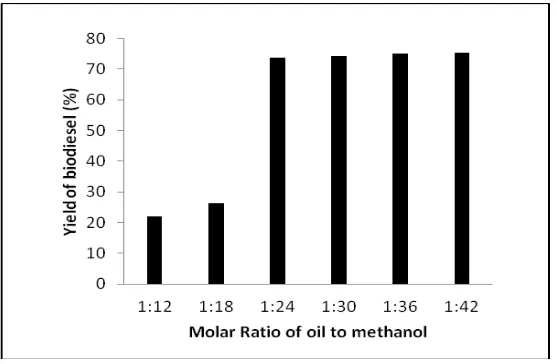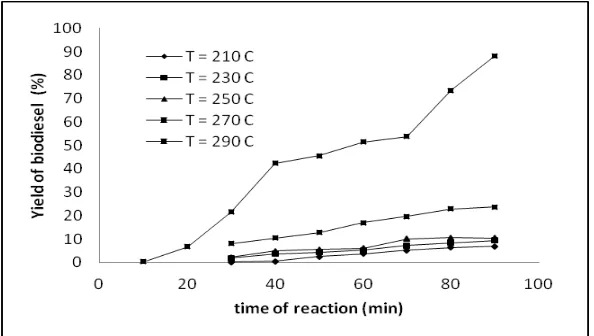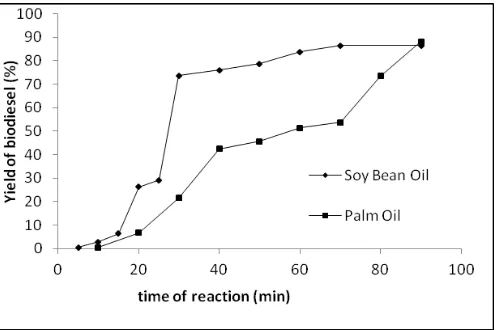Transesterification of Vegetables oil using Sub-and
Supercritical Methanol
Nyoman Puspa Asria,d, Siti Machmudah a,b, Wahyudionoc, Supraptoa, Kusno Budikarjonoa, Achmad Roesyadia, Mitsuru Sasakic, Motonobu Gotob
a
Chemical Engineering Department, Industrial Technology Faculty, Sepuluh Nopember Institute of Technology, Surabaya, INDONESIA 60111 b
Bioelectrics Research Center, Kumamoto University, Kumamoto 860-8555, JAPAN c
Graduate School of Science and Technology, Kumamoto University, Kumamoto 860-8555, JAPAN d
Chemical Engineering Department, Faculty of engineering, WR Supratman University, Surabaya, INDONESIA 60111 E-mail : [email protected]
Abstract :
A benign process, non catalytic transesterification in sub and supercritical methanol method was used to prepare biodiesel from vegetables oil. The experiment was carried out in batch type reactor (8.8 ml capacity, stainless steel, AKICO, JAPAN) by changing the reaction condition such as reaction temperature (from 210°C in subcritical condition to 290°C in supercritical state in ranges of 20°C), molar ratio oil to methanol (1:12-1:42) and time of reaction (10-90 min). The fatty acid methyl esters (FAMEs) content was analyzed by gas chromatography-flame ionization detector (GC-FID). Such analysis can be used to determine the biodiesel yield of the transesterification. The results showed that the yield of biodiesel increases gradually with the increasing of reaction time at subcritical state (210-230oC). However, it was drastically increased at the supercritical state (270-290oC). Similarly with the influence of molar ratio oil-methanol, yield biodiesel sharply increased with increasing ratio molar of oil-methanol up to 1:24. The maximum yield 86 and 88% were achieved for soybean oil and palm oil, respectively, at 290oC, 90 min of reaction time and molar ratio of oil to methanol 1:24.
Keywords: free catalyst, sub-and supercritical methanol, transesterification, vegetables oil
1. Introduction
Currently biodiesel is alternative energy very promising to be developed as replacing for diesel oil [1, 2]. Biodiesel has many advantages, especially; it is friendly environments because it is produced by renewable materials such as vegetable oils, animal oils, algae and used cooking oil. Moreover, biodiesel has a tremendous potential in reducing pollutants and carcinogenic agents in other words it produces lower emissions. Currently, biodiesel is generally produced by conventional methods using homogeneous base catalyst [1-4]. In this process, however, free fatty acids contained in triglycerides (mainly raw materials containing high free fatty acid > 0.5%) reacted with the catalyst to produce saponification products that are not desired. The process requires the complex purification steps to eliminate saponified product as well as catalyst, eventually resulting in the lower yield of biodiesel. Therefore, this conventional process still needs high production cost and energy consumption
[5-7]. Many researchers are challenged to do research to find a method or an efficient process technology for the production of biodiesel in order to overcome those problems.
Transesterification with heterogeneous catalysts is one of the most promising alternative to produce biodiesel from vegetable oils, so it would be able to overcome the weaknesses of homogeneous catalysts used. Heterogeneous catalytic process is expected to be an effective process and provide a minimal impact on the environment. Kouzu et al. conducted transesterification of soybean oil with refluxing methanol using CaO, Ca (OH)2 and CaCO3) as solid base catalyst [6]. They reported that after one hour of reaction time , yield of Fame was
93% for CaO, 12 % for Ca(OH)2 and 0% for CaCO3. Calcium Oxide which supported by -alumina catalyst has also
One other method, the noble proceeses, is environmental friendly transesterification of vegetable oil without catalysts in supercritical methanol, as reported by Saka and Kusdiana [10]. This method is very attractive process to overcome the problems of the use of homogeneous catalyst. Kusdiana and Saka, reported that 80% conversion of rapeseed oil into biodiesel was achieved at 240 s and 300oC. While, at 350oC within 4 minutes the conversion had increased sharply reaching 95% [5]. Thermal stability of biodiesel from various vegetable oils has been studied in supercritical methanol between 270oC/17/56 MPa and 380 Mpa [3]. Minami and Saka studied kinetics of hidrolyses and methyl esterification for the manufacture of biodiesel in two-step supercritical methanol process
[4]. On the other hand, Qadariah et al. studied the degradation of glycerol with Supercritical water method [11]. Supercritical methanol process has several advantages, including: eco-friendly, easy to sparate because it does not use catalyst. In addition, the diffusion problem can be overcome because at the supercritical state methanol has a hydrophobic nature with the lower of dielectric constant. As a result, the t o phase’s ature of oil a d etha ol are turn into mutually soluble phases. Meanwhile, on supercritical methanol the presence of water is not effecting the conversion of oil into biodiesel. In contrary, its existence enhances the formation of methyl ester and esterification of free fatty acids simultaneously in one stage [4]. However, the transesterification of palm oil in sub-and supercritical methanol without catalyst has not been yet observed. Similarly, very little information about the transesterification of soybean oil with methanol in sub-and supercritical state.
In this work, therefore, focuses on the transesterification of palm oil to biodiesel catalyst-free in batch
rea tor. I do esia has produ ed pal oil er a u da t used, that’s why we used palm oil to become the raw material for making biodiesel [12]. Furthermore, the transesterification of soybean oil in sub-and super-critical methanol was compared to that of palm oil. The effect of different operational parameters (reaction temperature, reaction time and molar ratio oil to methanol) on the yield of biodiesel were observed.
2. Material and Methods
2.1. Material
Palm oil and soybean oil for starting material was provided by Wako pure chemicals Co., Japan. Analytical grade of methanol and hexane and methyl esters standard (methyl palmitate, methyl stearic, methyl linoleic, methyl linolenic and methyl oleic) were supplied by Wako pure chemicals Co., Japan.
2.2. Uncatalyzed transesterification in sub and supercritical methanol
Uncatalyzed transesterification of palm oil and soybean oil in sub and supercritical methanol was carried out in a batch type reactor (8.8 ml, stainless steel SUS 304, AKICO Co., Japan). The reactor system used consists of an electric furnace (ISUZU Co, Ltd., model NMF-13AD), a stainless steel SUS 304 of reactor (8.8 ml of capacity, 300oC of maximum temperature, 30 MPa of pressure) and temperature controller. First of all, the temperature of the heating furnace was adjusted to the desire of temperature (210oC -290oC). The reactor was firstly charged with the mixture of palm oil and methanol in a certain molar ratio oil to methanol then the reactor was inserted to the electric furnace. The effect of different operational parameters (reaction temperature, reaction time and molar ratio oil to methanol) on the yield of biodiesel were observed. After reaching the set point of temperature, at which point the reaction was kept until the time of reaction was achieved. The pressure of the reaction was measured between 4-12 MPa. Afterwards, the reactor was removed from the electric furnace and immersed in a water bath for cooling in order to stop the reaction. The treated liquid discharged from the reactor into a sampling bottle. Amount of water were added into the solution mixture for diluting the excess of methanol. Subsequently, the solution mixture was centrifuged to separate it into two phases. The top phase was FAMEs (biodiesel) and a small amount of un-reacted oil. The bottom phase consisted of methanol, water and glycerol. Biodiesel was analyzed by gas chromatography-flame ionization detector (GC-FID) (Gas Chromatography GC-14B, Shimadzu, Japan) equipped with a HP-Innowax capillary column (30 m x 0.250 mm x 0.25 m). The oven temperature was programmed as follow: initial temperature of 210oC was hold for 9 min, increased to 230°C at 20°C/min interval for 20 min, then increased to 250oC at 20oC/min interval for 5 min. The injector and detector temperatures were controlled at 250 and 300°C, respectively. The injection volume was 1 l. The carrier gas was helium and the makeup gas was hydrogen. The analyses of biodiesel can be used to determine the yield % of biodiesel and the conversion of palm oil, which was defined as follows:
Where, W of biodiesel actual and W of oil are actual weight of biodiesel from the experiment (mg) and weight of oil used in the experiment (mg), respectively.
3. Result and Discussion.
3.1. Effect of molar ratio oil to methanol on yield of biodiesel
The molar ratio of oil to methanol is one of the most important variables that affecting the yield of FAMEs (biodiesel) obtained. Theoretically, the stoichiometry of transesterification reaction requires three moles of methanol to react with one mole of triglyceride produced three moles of FAMEs and one mole of glycerol. Since it is an equilibrium reaction an excess of methanol will increase the yield of biodiesel by shifting the equilibrium to the right side. Generally, in the conventional process used molar ratio of oil to methanol 1:6. However, transesterification in supercritical methanol that have been done by many earlier researchers, such as Imahara et al., Minami and Saka, Kusdiana and Saka, Saka and Kusdiana use molar ratio higher than that of homogeneous catalysts, with values that varies depending on the materials and process used [3-5, 10]. In this work, therefore, the effect of molar ratio of soybean oil to methanol on the yield of biodiesel was studied in the range between 1:12 to 1:42. Reaction was carried out in the batch reactor with sub and super-critical methanol; meanwhile the reaction temperature and the reaction time were kept constant 290oC and 30 min, respectively. Figure1 shows the influence of molar ratio soybean oil to methanol on the yield of biodiesel. The increasing molar ratio of soybean oil to methanol resulted in higher yield of biodiesel. By the increasing molar ratio from 1:12 to 1:18 the yield of biodiesel gradually increased from 22 to 26%. However, at 1:24 of molar ratio the yield biodiesel drastically increased to 73.66%. Beyond the molar ratio of 1:24 (1:30-1:42) the excessively added methanol had no significant effect on the yield of biodiesel. Meanwhile, Kusdiana and Saka in their studies of transesterification of rapeseed oil in supercritical methanol performed on temperature 350o C with ratio molar varying from 1: 3 to 1: 42 [5]. Their result shows, that for molar ratio oil to methanol 1:42, almost complete conversion was achieved in a yield of 95% of biodiesel. It can be concluded that the higher molar ratio of soybean oil to methanol the higher biodiesel yield was obtained until a certain molar ratio of soybean oil to methanol. Practically, too much excess of methanol is not favorable because too much energy is needed to recover it, which is finally increasing the total production cost of biodiesel. In this work, therefore, the optimum molar ratio of soybean oil to methanol was 1:24.
Figure 1. Yield of biodiesel (%) at various molar ratio soybean oil to methanol
3.2. Effect of reaction time and reaction temperature on yield of biodiesel
biodiesel increased with the increasing reaction time at all reaction temperatures. Figure 2 and Figure 3 show the effect of reaction time on yield of biodiesel at various temperature of reaction for soybean oil and palm oil, respectively. As shown in Figure 2 at 210 and 230oC, biodiesel yield rise gradually with increasing time. This is because at those temperature methanol are on subcritical conditions, so oil and methanol is not mixed in with perfect causing the reaction runs slowly, so that the resulting low yield. At 250oC biodiesel yield higher than the temperature both before, but biodiesel yield still gradually increase along with the increase in time. This is possible because 250oC is relatively too close to critical point, so it is still affected by the stability of supercritical methanol condition. However at 270oC the yield of biodiesel drastically increases from 19 to 73% within 30 min and 60 min, respectively. Beyond the 60 min which occurred opposite, where yield of biodiesel rising gradually along the increasing time of reaction and the highest yield 77% was achieved within 90 min.
Figure 2. Yield of biodiesel (%) from soybean oil as a function of reaction time at various temperature of reaction
O super riti al etha ol the ature of a i ture of t o phase’s oil a d etha ol easil o erted i to o e
phase because methanol is experiencing a reduction in dielectric constant. It does can be explained that liquid methanol is a polar solvent and has hydrogen bonding. The degree of hydrogen bonding decrease with increasing temperature, the polarity of methanol would decrease in supercritical state. This means that supercritical methanol has a hydrophobic nature with the lower dielectric constant [5, 13].
The influence of reaction time on the yield of biodiesel on various temperature reactions of Palm oil was shown on Figure 3. For palm oil, it was seen that the yield of biodiesel rose in line with the extension of time and temperature reaction. The gradient yield of biodiesel at subcritical temperature (210 and, 230oC) and at near a critical point (250oC) of palm oil are much lower than soybean oil. Even at a temperature of 270oC, the biodiesel yield was still low but it gradually increases a long with the increase in time of reaction.
However, at 290oC the yield of biodiesel sharply increased from 0.4 to 88 at 10 min up to 90 min. Figure 4 shows, the comparison of the yield of biodiesel on various reaction times at 290oC between soybean oil and palm oil. Around 10 min to 70 min yield biodiesel gradually increase as the reaction time passed by, but the value on each time is much lower than soybean oil. Meanwhile, beyond 70 min (70 up to 90 min) the yields of biodiesel drastically increase from 54 to 88%. This is might be possible due to the physical properties of palm oil (viscosity, density and freezing point) higher than soybean oil. Therefore, it need much longer time than that of soybean oil for achieving the setting temperature.
Figure 4. Yield biodiesel (%) at various time of reaction (min) at 290oC for soybean oil and palm oil.
4. Conclusion
An environmental friendly transesterification of vegetable oil (soybean oil and palm oil) without catalysts in sub and super-critical methanol was carried out in a batch type reactor system (AKICO Co., Japan). The effect of molar ratio oil to methanol, reaction time and reaction temperature were investigated. It was found that molar ratio oil to methanol, reaction temperature and reaction time was significantly influenced the biodiesel yield for both of oil. The optimum molar ratio of oil to methanol is 1:24. The maximum yield 86 and 88% were obtained at 90 min and 290oC for soybean oil and palm oil, respectively. At subcritical condition and near critical point the relative low yield were obtained for both of oil (soybean and palm oil). However, at supercritical methanol the yield of biodiesel drastically increased a long with the increasing the time of reaction. Therefore can be concluded, that transesterification vegetable oil with supercritical methanol is one of the potential process to overcome the drawback of conventional process.
Acknowledgements
The authors gratefully acknowledged The Directorate General of Higher Education of the Ministry of Education Republic of Indonesia for financial support. Special thanks to Applied Chemistry and Biochemistry Department, Engineering Faculty, Kumamoto University for technical assistance, and providing all of the facilities needed for the experiment.
References
[1] Joelianingsih, Maeda H, Hagiwara S, Nabetani H, Sagara Y, Soerawidjaya TH, Tambunan AH, Abdullah K. 2008. Biodiesel fuels from palm oil via the non catalytic transesterification in a bubble column reactor at atmospheric pressure: A kinetic study. Renewable Energy, 33: 1629-1636.
[2] Asri NP, Anisa A, Rizqi F, Roesyadi A., Budikaryono K, Suprapto, Gunardi I. 2010. Biodiesel Production from Palm oil Using CaO/Al2O3 as A Solid Base Catalyst. The 1st International Seminar on Fundamental & application Of Chemical Engineering
[4] Minami E, Saka S. 2006. Kinetics of hydrolyses and mehyl esterification for biodiesel production in two-step supercritical methanol process. Fuel, 85: 2479-2483.
[5] Kusdiana D, Saka S. 2001. Kinetics of transesterificationin rapeseed oil to biodiesel fuel as treated in supercritical methanol. Fuel , 80: 693-98.
[6] Kouzu M, Kasuno T, Tajika, Sugimoto Y, Yamanaka S, Hidaka J. 2008. Calcium oxide as a solid base catalyst for transesterifi atio of so ea oil a d it’s appli atio to iodiesel produ tio . Fuel, : 2 -806.
[7] Zabeti M, Daud WHAW, Aroua MK. 2009. Activity of solid catalysts for biodiesel production: A revew. Fuel Processing Technology, 90: 770-777.
[8] Zabeti M, Daud WHAW, Aroua MK. 2010. Biodiesel production using alumina –supported cacium oxide: An optimization study. Fuel Processing Technology , 91: 243-48.
[9] Asri NP, Hartanto F, Ramadhan R, Savitri SD, Gunardi I, Suprapto, Budikarjono K, Roesyadi A. 2011. Transesterification of pal oil to eth l ester usi g γ-alumina supported base catalysts. Proceeding of Bali International Seminar on Science and Technology (BISSTECH).
[10] Saka S, Kusdiana D. 2001. Biodiesel fuel from rapeseed oil as prepared in supercritical methanol. Fuel, 80: 225-31. [11] Qadariah L, Mahfud, Machmudah S, Wahyudiono, Sasaki M, Goto M. 2011. Degradation of glycerol using hydrothermal
process. Bioresources Technology, 102: 9267-9271.
[12] Herlina, 2011, Comodity of industry, www.industri,kontan.co.id . Accessed: 21th February 2011)


